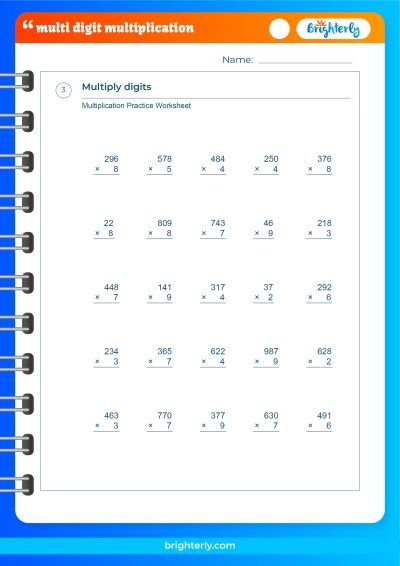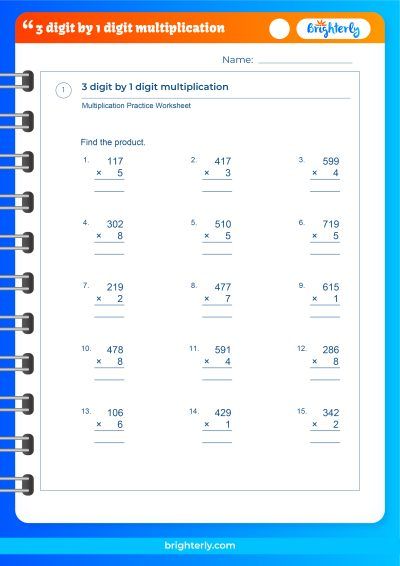Digit in Math – Definition with Examples
Updated on January 2, 2024
Welcome to another enlightening post from Brighterly, your reliable companion in making the world of numbers simpler, enjoyable, and comprehensive for children. Today, we dive into one of the most fundamental aspects of mathematics — the digit. Despite being the smallest unit in mathematics, digits form the basis of all numeric systems and play a crucial role in arithmetic and beyond. What is a digit in math? What role does it play? How does its position in a number impact the number’s value? We aim to answer these questions and more in this all-inclusive guide. At Brighterly, we believe that a strong foundation in understanding digits and their properties can make children’s journey through the broader aspects of mathematics a breeze.
What are Digits in Math?
When we think about mathematics, we often picture numbers, operations, and complex formulas. However, the most basic building block of all numbers in math is the humble digit. But what exactly is a digit? In the world of arithmetic, a digit is any one of the ten symbols: 0, 1, 2, 3, 4, 5, 6, 7, 8, and 9. These simple yet powerful symbols lay the foundation for all number systems, which are essential for our everyday math calculations. Whether we’re counting apples, measuring distances, or solving complex equations, digits are the tools we employ in our mathematical arsenal. It’s not just about the numbers; understanding the essence of digits can help enhance our comprehension and appreciation of math as a whole.
Definition of a Digit in Mathematics
In mathematics, a digit is defined as a single character used in numerals. As previously mentioned, we have ten digits in the base-10 or decimal number system that we use daily. These are 0-9. These numbers form the basis of all our mathematical operations, whether it’s simple addition or complex calculus. Each digit has a unique value, and when they come together to form larger numbers, their position also determines the overall number’s value. For instance, in the number 123, 1, 2, and 3 are all digits, but 1 represents hundred, 2 represents twenty, and 3 represents three. Hence, digits and their position within a number play a critical role in mathematics.
The Role of Digits in Mathematics
From simple arithmetic operations to complex equations, digits form the foundation of all mathematical activities. Each digit carries a unique value that contributes to the overall value of a number. When performing operations like addition, subtraction, multiplication, or division, we use these digits and their respective values. More importantly, in larger numbers, the position of a digit determines its place value, contributing significantly to the number’s total value. For instance, in the number 3456, the digit 3 is in the thousands place, 4 in the hundreds, 5 in the tens, and 6 in the ones place. The concept of place value is essential in the world of mathematics and is often one of the first concepts taught in primary school math education.
Properties of Digits
Each digit, from 0 through 9, possesses unique properties that make them an integral part of the number system. For example, zero (0) is the only digit that can be placed at the end of a number to increase its value tenfold. Meanwhile, one (1) is the identity for multiplication; any number multiplied by one stays the same. Each digit also has its set of prime and composite numbers. For instance, 2 and 3 are the only prime digits, while 4, 6, 8, and 9 are composite. Understanding these properties of digits aids in the comprehension of larger, more complex numbers and mathematical operations.
The Importance of Each Digit in a Number
Every digit plays a critical role in determining a number’s value. Take the number 789, for example. Here, 7 is in the hundreds place, 8 in the tens place, and 9 in the ones place. Without each digit in its proper place, the number would have a completely different value. For example, 987 is not the same as 789. This principle is called place value and is fundamental to our understanding of the number system. Recognizing the value of each digit in a number is vital for various mathematical operations, including addition, subtraction, multiplication, and division.
Difference Between Digits and Numbers
One common area of confusion in mathematics is the difference between digits and numbers. While they might seem synonymous, there is a significant distinction. A digit is a single symbol used to make numbers. There are only ten digits: 0, 1, 2, 3, 4, 5, 6, 7, 8, and 9. On the other hand, a number can be made up of one or more digits. For instance, 7 is a number made up of a single digit, while 77 is a number made up of two digits. Understanding this distinction is key to mastering many aspects of mathematics.
At Brighterly, we believe that practice is the key to mastery. That’s why we invite you to explore our digit worksheets, where you can find an array of additional practice questions, complete with answers.
Understanding Place Value of Digits
Place value is a fundamental concept in mathematics, built around the idea that the value of a digit depends on its position in the number. In the decimal number system, the rightmost place value is ‘ones’, followed by ‘tens’, ‘hundreds’, ‘thousands’, and so on. Each position holds ten times the value of the position to its right. For example, in the number 4567, the digit 7 is in the ‘ones’ place, 6 is in the ‘tens’ place, 5 is in the ‘hundreds’ place, and 4 is in the ‘thousands’ place. Understanding place value is crucial for all operations in mathematics, especially when carrying or borrowing in addition and subtraction.
Writing Numbers Using Digits
The beauty of digits is that we can use them to represent any number, no matter how large or small. By combining different digits in varying orders and positions, we can create all the numbers we use in daily life. For instance, the number ‘twenty-three’ is written using two digits: 2 and 3. The 2, being in the tens place, represents twenty, and the 3 represents three. So when we write numbers using digits, we need to understand the place value of each digit. This fundamental skill forms the basis of all numerical literacy.
Practice Problems on Digits in Mathematics
To better grasp the concept of digits, it’s important to practice with some exercises. Let’s consider a few examples:
- Identify the place value of 3 in the number 12345.
- Write the number seventy-nine using digits.
- What is the difference between the digit 2 and the number 22?
These exercises can help children understand the concept of digits, how they form numbers, and the role of place value. As they gain confidence, they can progress to more complex problems, enhancing their mathematical skills.
Conclusion
Every learning journey comes to an end, but each end is a new beginning. In our journey today at Brighterly, we’ve delved into the world of digits, exploring their definition, role, properties, and significance in our numeric system. We learned how each digit plays a pivotal role in the formation of numbers and how changing their position can impact the overall number’s value. We distinguished between digits and numbers and understood the immense power of place value.
Yet, as we conclude, we should remember that this is just a stepping stone into the vast ocean of mathematics. The real magic of digits unfolds as we climb higher on the ladder of mathematical concepts, opening doors to more complex calculations and number theories. At Brighterly, we are committed to making each step of this journey as enlightening and engaging as possible. After all, our goal is to light the spark of curiosity that fuels the quest for knowledge in every child.
Frequently Asked Questions on Digits in Mathematics
What is a digit?
A digit is a single character or symbol used in numerals. In the decimal number system that we use daily, there are only ten digits: 0, 1, 2, 3, 4, 5, 6, 7, 8, and 9. These digits are the basic units used to represent all numbers, and each digit carries a unique value that contributes to the overall value of the number it’s part of.
What is the difference between a digit and a number?
A digit is a single symbol used in representing numbers. There are only ten digits (0-9). On the other hand, a number is a mathematical object used to count, measure, and label. It can be composed of one or more digits. For instance, 3 is a digit that also represents the number 3. However, 33 is a number composed of two 3 digits.
What is place value?
Place value is a system in mathematics that assigns value to a digit based on its position within a number. In the decimal number system, the rightmost position is ‘ones’, followed by ‘tens’, ‘hundreds’, ‘thousands’, and so on as we move to the left. Each position is ten times the value of the position to its right. So in the number 456, the digit 4 is in the hundreds place, 5 is in the tens place, and 6 is in the ones place. Place value is a fundamental concept that underpins our understanding and operations of numbers.






